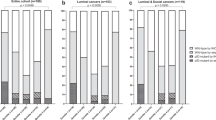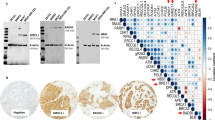Abstract
p53 messenger RNA expression was examined using a cDNA probe in 76 fresh primary breast tumour specimens, 15 of which came from patients treated with toxoxifen prior to surgery. A 2.8 kb mRNA for p53 was expressed in 43 of the 76 specimens. In 19 tumours the levels were similar to those seen in non-malignant (reduction mammoplasty) breast tissue, but in 24 tumours over-expression of mRNA for p53, approaching that seen in three breast cancer cell lines, was found. The cell lines MCF-7, T-47D and MDA-MB-231 expressed three p53 mRNA species of about 2.8 kb and a forth of 1.6 kb. Increased mRNA expression for p53 correlated (P less than 0.05) with loss of genetic material from the short arm of chromosome 17 as demonstrated by allele loss with the VNTR probe YNZ 22.1. There was also statistically significant correlation between increased p53 mRNA expression and low oestrogen receptor protein content in the tumours (P less than 0.05), but not with other clinical parameters. The findings support the view that p53 is involved in breast tumour biology, and suggest that its role may be complex.
This is a preview of subscription content, access via your institution
Access options
Subscribe to this journal
Receive 24 print issues and online access
$259.00 per year
only $10.79 per issue
Buy this article
- Purchase on Springer Link
- Instant access to full article PDF
Prices may be subject to local taxes which are calculated during checkout
Similar content being viewed by others
Author information
Authors and Affiliations
Rights and permissions
About this article
Cite this article
Thompson, A., Steel, C., Chetty, U. et al. p53 gene mRNA expression and chromosome 17p allele loss in breast cancer. Br J Cancer 61, 74–78 (1990). https://doi.org/10.1038/bjc.1990.17
Issue Date:
DOI: https://doi.org/10.1038/bjc.1990.17
This article is cited by
-
Genetic Prognostic Index Influences Patient Outcome for Node-Positive Breast Cancer
Surgery Today (2006)
-
Correlation of allelic loss with poor postoperative survival in breast cancer
Breast Cancer (1999)
-
Anti-invasion drugs
Breast Cancer Research and Treatment (1996)
-
Prognostische relevanz von mutiertem P53-Protein und DNA-Flußzytometrie beim Mammakarzinom
European Surgery (1995)
-
Familial breast cancer and genes involved in breast carcinogenesis
Breast Cancer Research and Treatment (1995)



